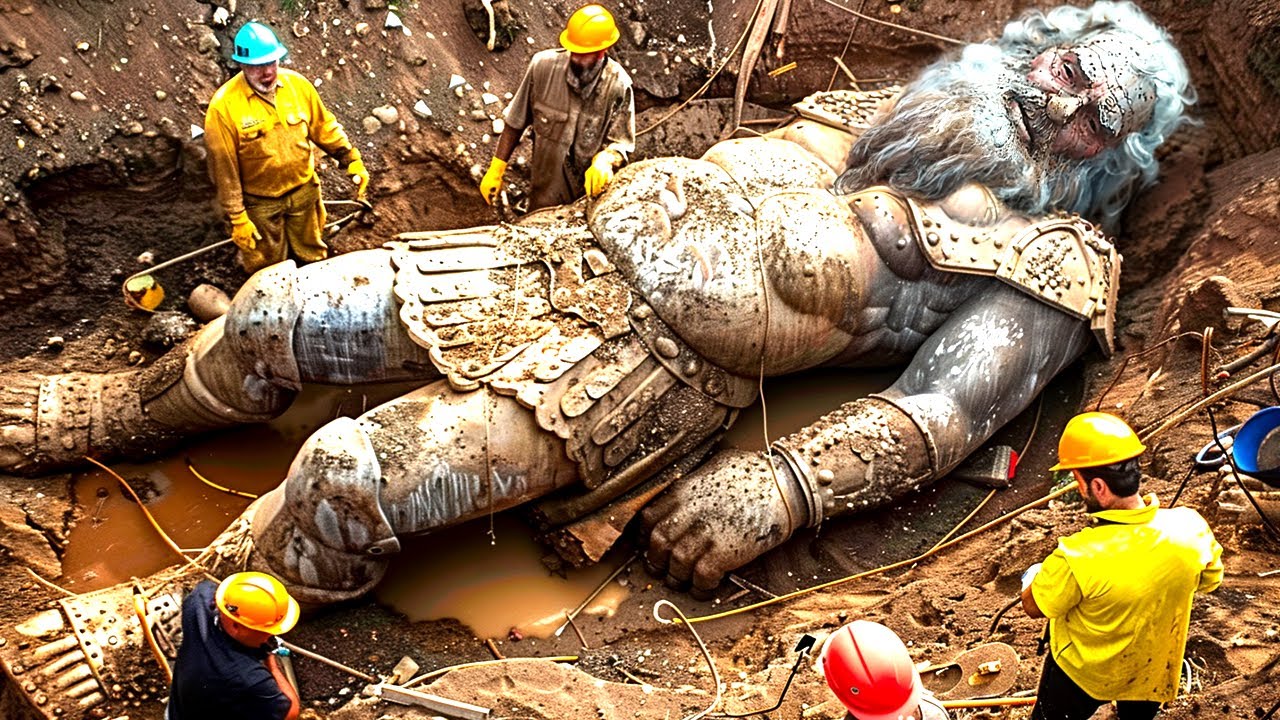
Scientists have finally opened the giant Goliath’s tomb. There has long been a mystery about an old tomb that has been shut for thousands of years.
We must go back to the story of Goliath in order to appreciate the significance of this revelation fully. The Bible describes Goliath as a huge warrior from the Philistine army who was renowned for his extraordinary strength and size. The fight he had with young shepherd David, who went on to become king of Israel, is what made him most renowned.
One of the most well-known legends from the Old Testament is this one, which can be found in the Book of Samuel. It represents the victory of bravery and faith over fear and raw strength.
Goliath is portrayed as having a big spear in his hand, heavy armour, and standing over nine feet tall. David used a simple sling and a few stones to overcome him despite his intimidating look. This triumph is still a potent symbol in many cultures and has been portrayed in innumerable artworks.
The Goliath myth has captivated historians and archaeologists for years. Numerous people have conjectured about the presence of his tomb and undertaken multiple quests to locate it. The changing Middle Eastern terrain and the passage of time have made the quest difficult.
Recent years have seen a breakthrough as a group of archaeologists discovered a probable location in the ancient city of Gath, which is traditionally thought to be Goliath’s hometown.
Through the use of cutting-edge technologies such as satellite imagery and ground-penetrating radar, they were able to locate what looked to be an old burial ground covered in layers of trash and earth.
The tomb’s excavation was a careful and sensitive procedure. The group faced several difficulties under the direction of famous archaeologist Dr. Miriam Cohen, who specialized in Middle Eastern antiques. These included the artifacts’ inherent fragility and the ongoing danger of looters.
Following several months of meticulous excavation and earthsifting, the team discovered a sizable stone building that was recognized as a tomb. Goliath of Gath, the tomb’s occupant, was confirmed by writings in an old script found on a large stone slab that shut the entrance.
The time of tomb unveiling was eagerly awaited and meticulously executed. When the stone slab was carefully lifted away, the interior of the tomb became visible—a tiny, gloomy corridor.
The researchers discovered other chambers within that had relics and artifacts that provided insight into Goliath’s life and times. The most remarkable find was a large sarcophagus that was intricately adorned with inscriptions and carvings that showed mythological and combat scenes.
The researchers discovered the skeletal remains of a big man—roughly nine feet long—inside the sarcophagus. This man’s size matches the biblical account of Goliath. The exceptionally well-preserved bones belied the remarkable stature and strength of the individual. Armour and weapons, including a huge bronze sword and fragments of a helmet, surrounded the skeleton.
Other items discovered in the tomb included tools, jewelry, and ceramics that provided important insights into the daily lives and cultures of the Philistines. Written in an old script that predates the majority of known Philistine literature, the tomb’s inscriptions provide fresh data for linguistic and historical research.
The finding of Goliath’s tomb has significant historical and cultural ramifications in addition to being an archaeological marvel. It offers verifiable proof of the Philistines, a people group frequently referenced in biblical writings but with little knowledge otherwise. We can learn more about their daily lives, workmanship, and culture thanks to the artifacts discovered in the tomb.
Additionally, the Goliath skeleton offers a rare chance for scientific investigation. According to preliminary research, Goliath might have had gigantism, a disorder that results in abnormal development because of hormonal imbalances. The biblical account of his remarkable height and athletic prowess is supported by this study. The bones have substantial deterioration, suggesting a life of fighting and physical exertion.
Modern technology was essential to the finding and examination of Goliath’s tomb. The location of the site was made possible by satellite imagery and ground-penetrating radar, and the creation of precise reconstructions of the tomb and its contents was made possible by digital reconstruction and 3D scanning.
Additionally, DNA analysis is being done to find out more about the genetic characteristics of the Philistines and Goliath’s lineage.
This information may contribute to a better understanding of human history by shedding light on the ancestry and migration patterns of prehistoric people living in the area.
The discovery of Goliath’s grave has rekindled discussions among historians and biblical experts. While some welcome the discovery as proof that the Bible is historically accurate, others warn against making hasty judgments and stress the need for further data before making solid judgments.
Whatever one’s viewpoint, there is no denying that the discovery opens up new avenues for the analysis of biblical texts. It creates a concrete link between myth and history and stories that have been passed down through the ages.
Like any archaeological find, there are moral dilemmas surrounding the excavation of Goliath’s grave. Human remains, particularly those of notable historical and cultural personalities, must be handled with respect and sensitivity.
Other items discovered in the tomb included tools, jewelry, and ceramics that provided important insights into the daily lives and cultures of the Philistines. Written in an old script that predates the majority of known Philistine literature, the tomb’s inscriptions provide fresh data for linguistic and historical research.
The finding of Goliath’s tomb has significant historical and cultural ramifications in addition to being an archaeological marvel. It offers verifiable proof of the Philistines, a people group frequently referenced in biblical writings but with little knowledge otherwise. We can learn more about their daily lives, workmanship, and culture thanks to the artifacts discovered in the tomb.
Additionally, the Goliath skeleton offers a rare chance for scientific investigation. According to preliminary research, Goliath might have had gigantism, a disorder that results in abnormal development because of hormonal imbalances. The biblical account of his remarkable height and athletic prowess is supported by this study. The bones have substantial deterioration, suggesting a life of fighting and physical exertion.
Modern technology was essential to the finding and examination of Goliath’s tomb. The location of the site was made possible by satellite imagery and ground-penetrating radar, and the creation of precise reconstructions of the tomb and its contents was made possible by digital reconstruction and 3D scanning.
Additionally, DNA analysis is being done to find out more about the genetic characteristics of the Philistines and Goliath’s lineage.
This information may contribute to a better understanding of human history by shedding light on the ancestry and migration patterns of prehistoric people living in the area.
The discovery of Goliath’s grave has rekindled discussions among historians and biblical experts. While some welcome the discovery as proof that the Bible is historically accurate, others warn against making hasty judgments and stress the need for further data before making solid judgments.
Whatever one’s viewpoint, there is no denying that the discovery opens up new avenues for the analysis of biblical texts. It creates a concrete link between myth and history and stories that have been passed down through the ages.
Like any archaeological find, there are moral dilemmas surrounding the excavation of Goliath’s grave. Human remains, particularly those of notable historical and cultural personalities, must be handled with respect and sensitivity.
To make sure that the excavation is carried out in a way that respects the customs and beliefs of those connected to the site, Dr. Cohen and her team have collaborated extensively with religious leaders and local communities.
This is not the end of Goliath’s tomb unveiling. In the upcoming years, a thorough examination of the artifacts and bones taken from the site will be conducted. Scholars from many fields, such as history, anthropology, and archaeology, will work together to uncover the mysteries surrounding this prehistoric giant and his environment.
Additional tombs or buildings may be found during nearby excavations, adding to the context and knowledge of the Philistine society. Every new finding will contribute a piece to the puzzle, enabling the construction of a more comprehensive image of this fascinating period in history.
Global interest has been sparked by the discovery of Goliath’s tomb, capturing the public’s imagination. It has sparked conversations about the nexus of mythology, science, and history in news stories, films, and academic conferences.
Some of the artifacts will be on show at museum displays soon, giving the public a chance to view the riches found in Gath. Public lectures and educational programs are also being planned to disseminate the knowledge obtained from this remarkable discovery.
An important turning point in the history of archaeology was the discovery of Goliath’s tomb. Offering fresh perspectives on the ancient world, it breathes life into a tale that has been a part of human civilization for thousands of years.
We can anticipate learning even more about Goliath, the Philistines, and the larger historical setting in which they lived as scientists continue to examine the results.
This finding is evidence of the ongoing strength of human curiosity and the unwavering quest for knowledge. It serves as a reminder that wonders and mysteries yet remain to be solved in the current era. The tomb of Goliath serves as a link between the past and present as we look to the future, tying us to our shared history and the tales that shape who we are.
In conclusion, the discovery of Goliath’s tomb contributes to our knowledge of ancient civilizations while also validating a number of historical and biblical tales.
It emphasizes how crucial archaeology is to learning the truths about the past and how it continues to influence how we view the past. The intriguing narrative of Goliath’s tomb’s transformation from mythology to reality serves as a poignant reminder of the intricate web of myths and histories that cries out to be discovered and comprehended.
Please don’t forget to “Allow the notification” so you will be the first to get our gist when we publish it.
Drop your comment in the section below, and don’t forget to share the post.





